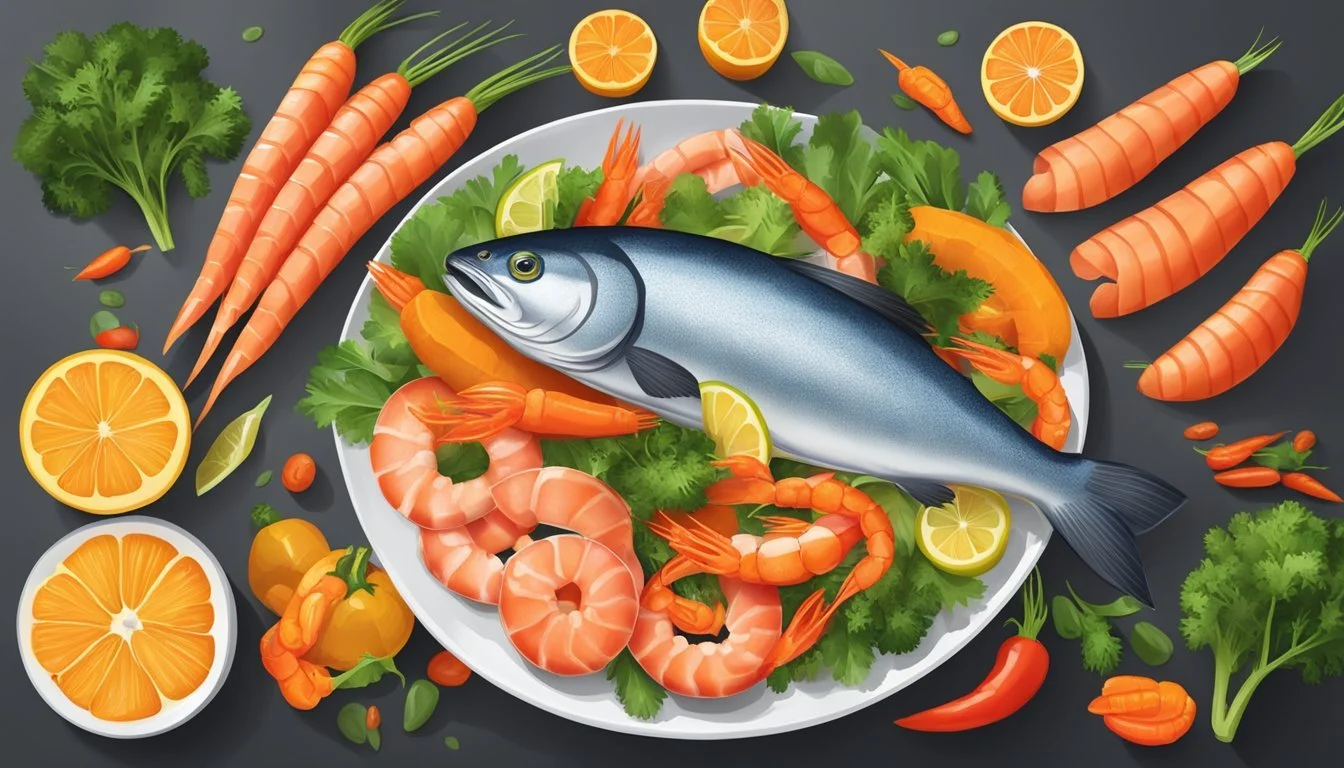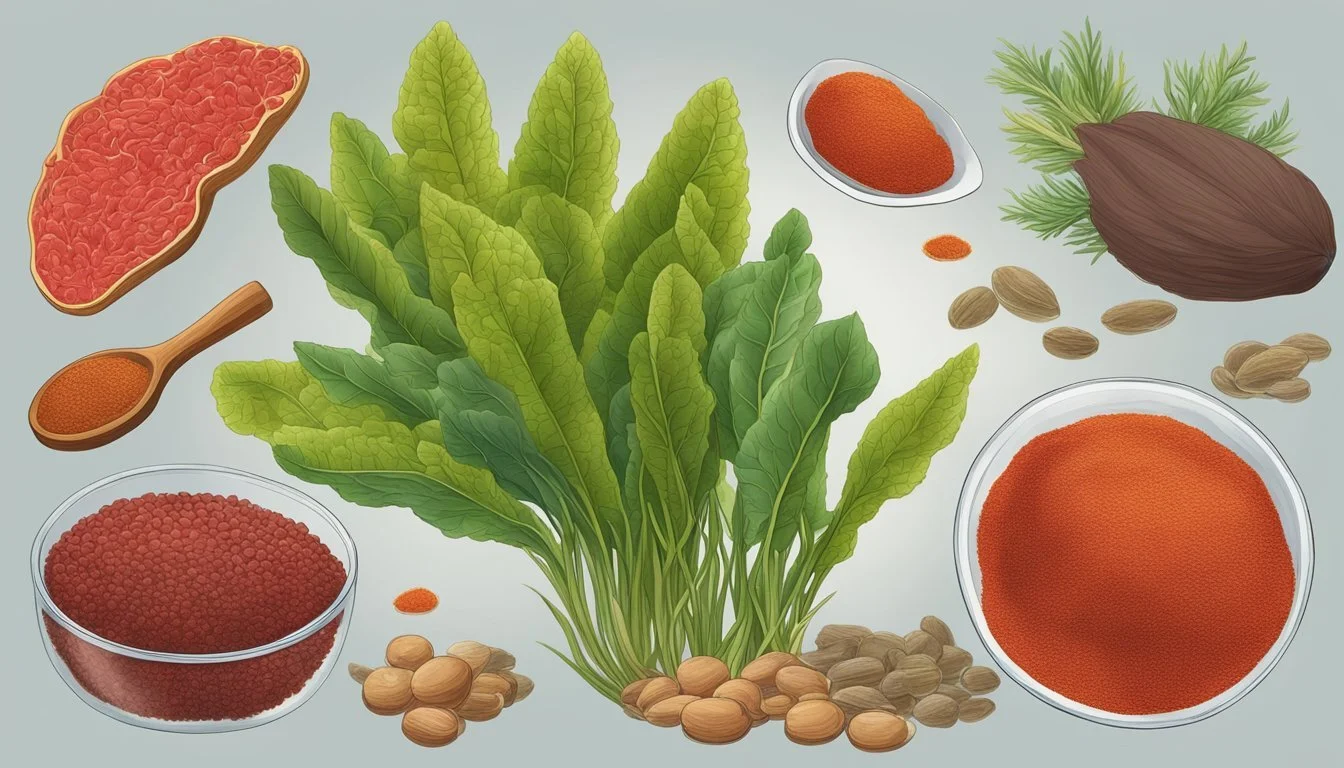10 Astaxanthin-Rich Foods to Boost Your Antioxidant Intake
Top Sources and Health Benefits
Astaxanthin is a powerful antioxidant found primarily in certain seafood and algae. Recognized for its vibrant reddish-orange color, this nutrient plays a significant role in promoting overall health. It's known for its potential benefits for the brain, heart, skin, and eyes.
For those looking to enhance their diet with foods rich in astaxanthin, understanding which foods contain the highest levels is crucial. Seafood, such as salmon and various types of shellfish, are commonly mentioned sources of this carotenoid. By incorporating these astaxanthin-rich foods into their meals, individuals can take advantage of the various health benefits associated with this potent antioxidant.
1) Red King Crab
Red King Crab is a prominent source of astaxanthin found in marine life.
These crabs feed on various invertebrates and macroalgae, which are rich in this antioxidant. The astaxanthin content in their diet contributes to the vibrant color and potential health benefits of the crab.
Studies suggest that dietary astaxanthin influences the coloration of Red King Crab. They exhibit lower hue and higher saturation levels when their diet is rich in this compound.
Aquaculture facilities often consider astaxanthin a crucial component in the diet of hatchery or laboratory-reared Red King Crab juveniles for optimal growth and health.
2) Pacific Salmon
Pacific salmon is a rich source of astaxanthin, a potent antioxidant. Both wild Pacific and farmed Atlantic salmon contain significant levels of the compound.
Astaxanthin in Pacific salmon contributes to its pinkish-red color. This antioxidant can support skin health by reducing UV-induced damage and maintaining a healthy skin barrier.
Health effects of consuming Pacific salmon include reduced inflammation and enhanced immune response. The high levels of astaxanthin also support cardiovascular health by lowering oxidative stress.
Consuming Pacific salmon, either fresh or cooked, consistently provides a reliable intake of astaxanthin. Including it in one’s diet can be a tasty way to benefit from this powerful antioxidant.
3) Trout
Trout is an excellent source of astaxanthin, a potent antioxidant. Both rainbow trout and red trout contain significant levels of this compound.
Astaxanthin gives trout its characteristic reddish-pink hue. It also provides several health benefits, such as enhancing the body's antioxidant defenses.
Farmed and wild trout offer varying amounts of astaxanthin. It's noted that wild-caught trout generally have higher levels compared to farmed varieties, making them a superior choice. Trout also delivers high-quality protein and essential nutrients.
In addition to its nutritional value, trout is also versatile in culinary applications. It can be prepared through various cooking methods, including grilling, baking, and smoking. This makes it a delightful addition to a balanced diet.
4) Lobster
Lobster is a well-known seafood that gets its vibrant red color from astaxanthin. This carotenoid pigment is not produced by the lobsters themselves but is accumulated through their diet, primarily from consuming astaxanthin-rich plants and algae.
Despite its high cost, lobster remains a popular choice for those looking to boost their intake of astaxanthin. It is important to note that lobster may not be practical for daily consumption due to both its price and potential health considerations.
Each serving of lobster can provide a significant amount of astaxanthin, contributing to its overall nutritional profile. This makes it a valuable addition to the diet for those seeking the benefits of this antioxidant.
5) Shrimp
Shrimp is a well-known source of astaxanthin, contributing to its reddish color after cooking. This pigment offers potent antioxidant properties, making shrimp a beneficial addition to the diet.
Shrimp contains approximately 1 to 2 micrograms of astaxanthin per gram. This concentration helps deliver antioxidant effects that can support overall health.
In addition to astaxanthin, shrimp provides essential nutrients like selenium, vitamin B12, vitamin D, and copper. These nutrients play vital roles in various bodily functions, including immune support and bone health.
However, it is essential to moderate shrimp consumption. While copper is necessary for the body, excessive intake can lead to liver issues. A balanced diet ensures that the benefits of shrimp are utilized without potential drawbacks.
6) Krill Oil
Krill oil is a potent source of astaxanthin, a powerful antioxidant found in marine life.
This oil derives from tiny crustaceans called krill, which consume algae rich in astaxanthin.
The deep red color of krill oil is due to its high astaxanthin content.
Each molecule of this antioxidant in krill oil is linked to an EPA fatty acid, enhancing its absorption and efficacy.
Krill oil offers several health benefits, including reduced cholesterol levels and improved immune function.
In addition to astaxanthin, it contains omega-3 fatty acids, making it a valuable dietary supplement.
Various studies have demonstrated that krill oil can have a more significant antioxidant effect than other carotenoids.
This makes it a highly effective anti-inflammatory and immune-boosting substance.
As krill oil is consumed in its natural state, the astaxanthin remains intact, thus providing maximum benefits.
Incorporating krill oil into a diet can be a straightforward way to increase astaxanthin intake.
It's available as a supplement and is often recommended for those seeking both cardiovascular and overall health improvements.
7) Phaffia Rhodozyma
Phaffia rhodozyma is a type of red yeast that is a prominent source of natural astaxanthin.
Astaxanthin is a potent antioxidant known for its numerous health benefits, including anti-inflammatory effects and free radical scavenging. P. rhodozyma produces this valuable carotenoid as its main fermentation product.
Researchers have worked on enhancing the yield of astaxanthin in P. rhodozyma by employing methods like classical random mutagenesis and optimizing the culture media. These efforts have significantly increased the production levels of astaxanthin.
This yeast can use agro-food waste, making it a sustainable option for astaxanthin production. Its capability to produce astaxanthin more efficiently than some other sources highlights its potential in the biotechnology and nutraceutical industries.
8) Red Yeast
Red yeast is a natural source of astaxanthin, a powerful antioxidant known for its reddish pigment. It is primarily cultivated from the yeast species Phaffia rhodozyma. This yeast is significant in the aquaculture industry because it enriches the pigmentation of farmed fish, like salmon and trout.
The astaxanthin concentration in red yeast can vary, but it often shows high potency levels comparable to some marine sources. Incorporating red yeast into one's diet can be beneficial, especially for those looking for plant-derived extracts.
Red yeast offers an alternative for individuals aiming to boost their intake of astaxanthin without relying solely on seafood. Though it’s a more niche source, its impact on health and diet should not be underestimated.
9) Microalgae
Microalgae are microorganisms known for their potent sources of astaxanthin. These tiny aquatic plants, particularly species like Haematococcus pluvialis and Chlorella zofingiensis, are renowned for their high astaxanthin content.
Haematococcus pluvialis is the most efficient producer of natural astaxanthin. This microalga can yield astaxanthin in large quantities, making it a preferred source for commercial production.
Chlorella zofingiensis is another notable microalga with potential for astaxanthin production. While not as prolific as Haematococcus pluvialis, it offers a viable alternative for natural astaxanthin extraction.
Astaxanthin derived from microalgae is highly valued due to its powerful antioxidant properties. It is widely utilized in pharmaceuticals, health supplements, cosmetics, and functional foods.
The extraction of astaxanthin from microalgae involves cultivating these organisms under specific conditions. These conditions optimize their astaxanthin production, ensuring maximum yield and quality.
Astaxanthin from microalgae is often favored over synthetic alternatives. This preference arises from the natural compound's superior bioavailability and efficacy in various health applications.
10) Arctic Char
Arctic Char is a fish known for its rich flavor and impressive nutritional profile. Found in cold, freshwater environments, it is a close relative of both salmon and trout.
This fish is one of the notable sources of astaxanthin, a powerful antioxidant. Wild Arctic Char contains about 8.5 mcg of astaxanthin per gram, making it a valuable addition to diets seeking this carotenoid.
In addition to astaxanthin, Arctic Char provides essential omega-3 fatty acids, EPA and DHA. These nutrients support heart and brain health, making Arctic Char a nutritious choice for balanced diets.
Its flesh is often pink to red due to the presence of astaxanthin, which also contributes to its appealing appearance. This makes Arctic Char not only a healthy option but also a visually attractive one for dishes.
The mild and slightly sweet taste of Arctic Char suits a variety of culinary preparations. It can be grilled, baked, or poached and pairs well with a range of sauces and seasonings.
Including Arctic Char in your diet can help diversify your sources of essential nutrients. It stands out for its astaxanthin content and overall nutritional benefits.
Health Benefits of Astaxanthin
Astaxanthin offers notable advantages for health, particularly due to its anti-inflammatory properties and powerful antioxidant strength.
Anti-Inflammatory Properties
Astaxanthin has been shown to reduce inflammation in the body. This benefit is crucial since chronic inflammation can lead to various health issues, including arthritis, heart disease, and even certain cancers. Studies indicate that astaxanthin works by inhibiting inflammatory compounds in the body, such as cytokines and enzymes.
Some evidence also suggests its potential in alleviating symptoms of inflammatory conditions like rheumatoid arthritis. By decreasing oxidative stress and curbing inflammation, astaxanthin helps in maintaining overall cellular health. It's especially beneficial for athletes as it can reduce exercise-induced muscle damage and improve recovery times.
Antioxidant Strength
Astaxanthin is known for its potent antioxidant properties, which protect cells from oxidative damage. Free radicals can damage cells, leading to aging and various diseases. Unlike other antioxidants, astaxanthin can cross the blood-brain barrier, providing protection to brain cells against oxidative stress.
Research has shown that astaxanthin is more effective than other antioxidants like vitamin E and vitamin C. It helps in maintaining healthy skin by preventing damage from UV exposure and improving skin elasticity. Additionally, astaxanthin supports cardiovascular health by protecting blood vessels and enhancing blood flow. The ability to neutralize free radicals makes it a vital nutrient for preserving long-term health.
How to Incorporate Astaxanthin-Rich Foods into Your Diet
Incorporating astaxanthin-rich foods into your diet can enhance your nutritional intake and boost antioxidant levels. Focus on thoughtful meal planning and practical recipes to make these foods a regular part of your diet.
Meal Planning Tips
When planning meals, it is beneficial to include seafood such as trout and shrimp. These are rich sources of astaxanthin that can be easily integrated into weekly menus.
Aim to eat these foods at least twice a week. Pair them with vegetables like kale and spinach, which contain complementary antioxidants. For those preferring plant-based options, including microalgae supplements could be beneficial, although direct consumption is less common.
Stock your pantry with high-quality sources. Look for labels indicating wild-caught or sustainable seafood to ensure nutrient retention. Consider frozen seafood options for convenience, which can still retain their nutritional value.
Meal prepping can also be useful. Prepare seafood dishes in advance and store them in portioned containers. This makes weekday meals easier without sacrificing nutrition.
Recipes and Preparation Ideas
Grilled trout is a simple and delicious way to get astaxanthin. Marinate trout fillets with lemon juice, olive oil, and herbs, then grill until cooked. Serve with a side of leafy greens like spinach for added nutrients.
Shrimp stir-fry is another quick recipe. Sauté shrimp with garlic, ginger, and mixed vegetables. Add soy sauce or teriyaki for flavor. Serve this over brown rice or quinoa to create a balanced meal.
For a vegan option, consider a smoothie with microalgae powder. Blend it with fruits like bananas and berries, along with a handful of spinach or kale. This makes a nutrient-dense breakfast or snack.
Incorporate soups that include seafood. A salmon chowder with potatoes, carrots, and celery in a creamy base provides both comfort and nutrition.
Experiment with these recipes and tips to make astaxanthin-rich foods a tasty and regular part of your diet.




